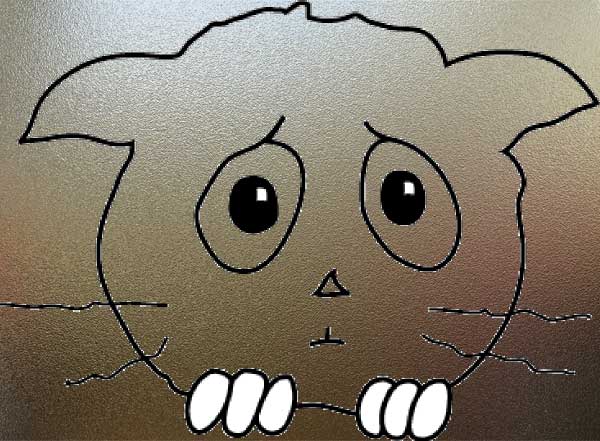The well-known adage, “Curiosity killed the cat” was originally, centuries earlier, “Care killed the cat”. The word “care” meaning to care about something or worry. In the 17th century, people believed that cats could die of worry or anxiety. That idea seems strange to us now and 25% of cat owners in the UK (in 2008) thought that their cat was incapable of feeling anxiety and sadness. I’d expect that figure to be lower in 2015 thanks to the internet and it’s educational advantages.

However, there is a grain of truth in the old adage “care killed the cat” and it applies today more than ever to what is euphemistically described as ‘inappropriate elimination’.
Cat owners should initially look to the mental health of their cat if there are urination problems such as urinating in the wrong place, difficulties in urinating and blood in urine. As many as 66% (two-thirds) of cats taken to veterinary clinics for urination problems don’t have any obvious signs of medical problems. The diagnosis is anxiety and stress – a psychological problem.
It appears that vets specialising in feline behavioural disorders regularly diagnose anxiety and fear as the main factors behind cats urinating and defecating indoors but outside of the litter tray. Anxiety, today, does constitute a real and debilitating problem for many cats. Although it should be noted that scientists are not sure how cats feel anxiety. Is it the same was as humans do?
By now, with mass information on the internet on these sorts of cat information topics, the majority of cat owners should realise that the most common cause of anxiety in cats is quite possibly worry over the invasion of their territory by other cats. Either that or in homes where there are more than cat, there may be tensions between them or some of them. There are many other sources of anxiety such as being alone for too long on a daily basis.
A survey of ninety homes in Hampshire and Devon in the UK, in 2000, found that almost 50 percent of cats regularly fought with other cats. Forty percent of the cats were fearful of cats in general. These are high numbers and indicate a problem which, arguably, is not being adequately addressed.
Out of a desire to deter other cats from entering the home, some cats spray walls or furniture. Some cats urinate as far from the cat flap as possible for fear of attracting the attention of other cats. In an effort to claim ownership of the core of the home, some cats defecate and/urinate on the bed. Hiding is evident in some fearful cats. These cats are under stress living with cats that they do not trust. The level of anxiety can affect their health, as mentioned.
The technical term for many urination problems is ‘idiopathic cystitis” – meaning no apparent medical reason for cystitis, a disease causing urination problems.
Idiopathic cystitis is less common in female cats than male cats. The reason is males are more territorial and less sociable than females and therefore find it harder to resolve and avoid conflicts with other cats.
When a male cat living with five others was demonstrating a lot of anxiety and difficulty urinating, his problems were resolved by providing an area exclusively his own, his own food and water bowl, his own litter tray and removing the ability to see stranger cats wandering into the garden.
When a cat feels anxiety for a long time, which is eminently possible in many homes, it can lead to elevated levels of stress hormones and a deterioration in health. Let’s think of our cats mental health.


Even tho Samirah does have some issues with anxiety she is always very good using the litter boxes and has never urinated outside them. She has two litter boxes, one in the living room and the other in the bathroom. I scoop them out 2 or 3 times a day.
With reference to your comment:
“When a cat feels anxiety for a long time, which is eminently possible in many homes, it can lead to elevated levels of stress hormones and a deterioration in health. Let’s think of our cats mental health.”
Prolonged stress almost always leads to deterioration in health, and if not reduced, can cause serious disease in cats and other animals, much like what is evident in humans.
When I first read the long list of “cat stressers” I learned some things I hadn’t thought of. This is a good reference for anyone who has cats that are exhibiting undesirable behaviors.
Stress can cause illness and disease. We also need to be aware of potentially toxic ingredients in what we feed our cats is also linked to a decline in health. Symptoms may not be noticed until it’s too late to reverse the damage.
So another good reference to keep on hand is the “pet food ingredient analysis” by Dr. Lisa Newman, which can be found by a search. I’ve printed out all 47 pages, so while I was trying various cat foods, I could look at the ingredient label online, and then refer to the analysis, before buying it.
Since I’ve switched my cat Mitzy to a raw diet that I purchase from a local manufacturer, her constipation issues have been resolved. I noticed this from the first day of feeding her the turkey/sardine mixture. It seems very unappetizing to me, but it’s the first time I’ve seen her eat everything on her plate. She also likes the chicken/sardine mix.
I’ve read that sardines don’t have the toxic load of the larger fish, so that must be why they use them.
Feeding raw is nearly half the price of feeding the canned crap, so it’s a win on both angles. Saving money and increasing health is very desirable.